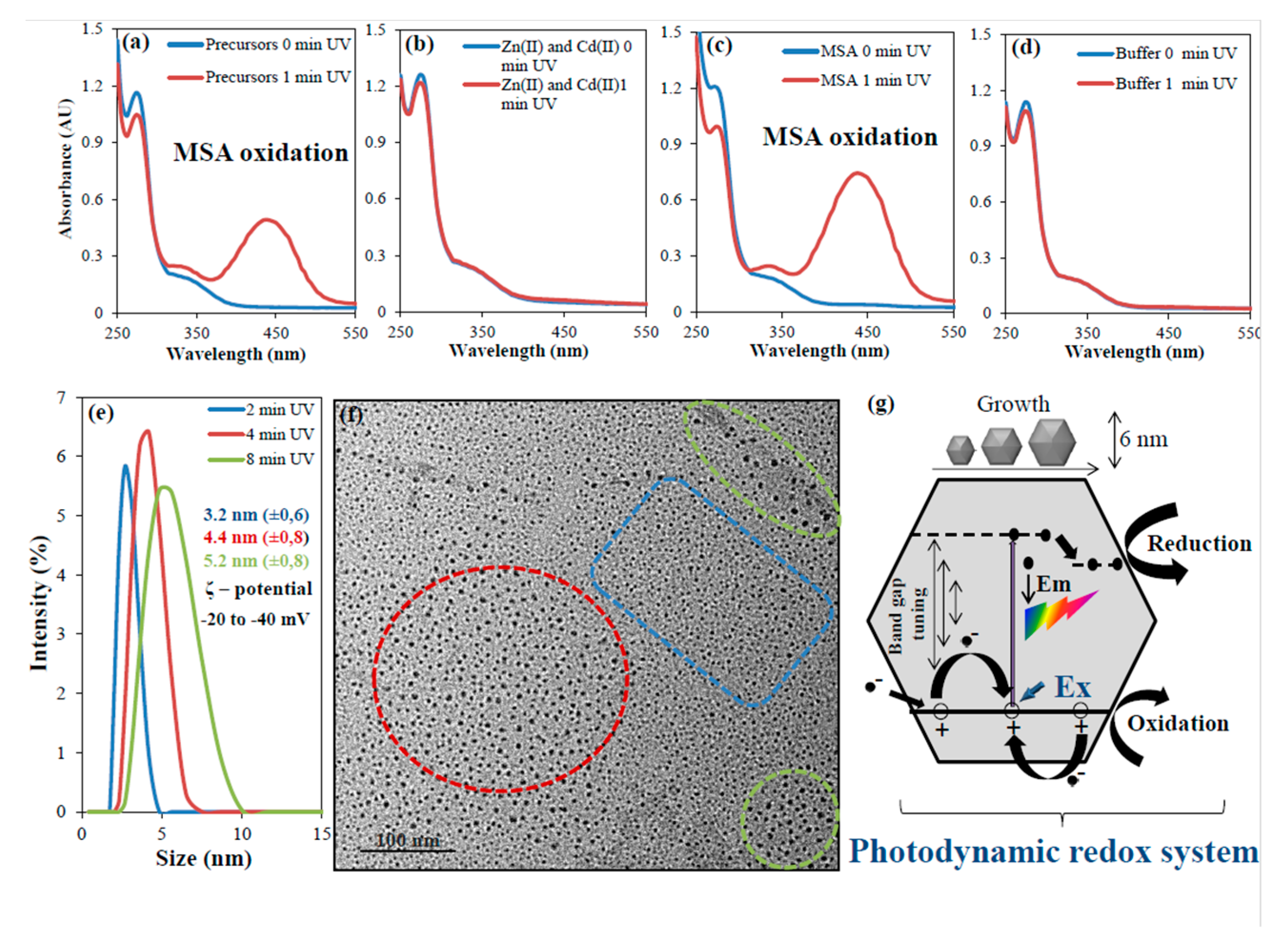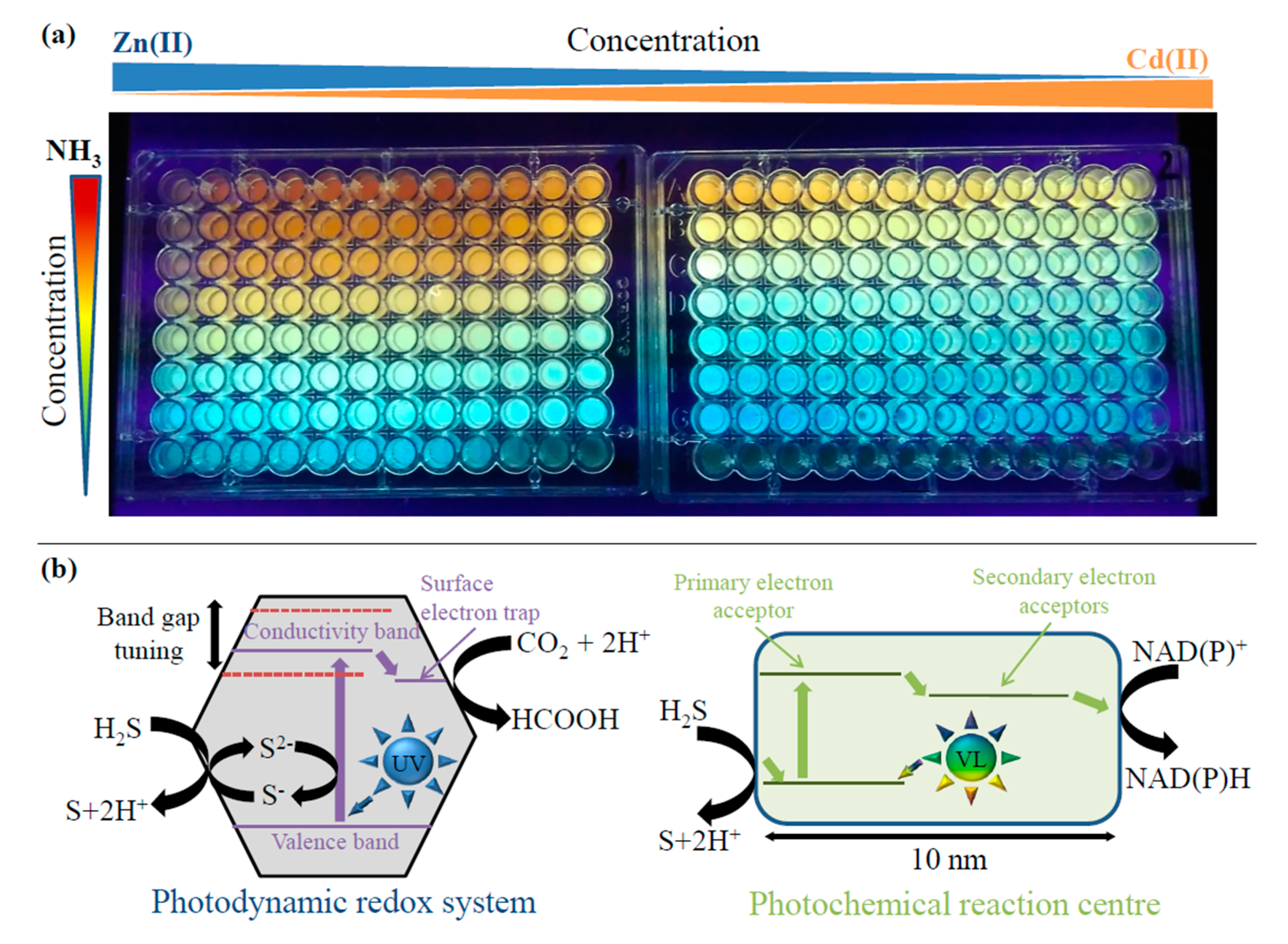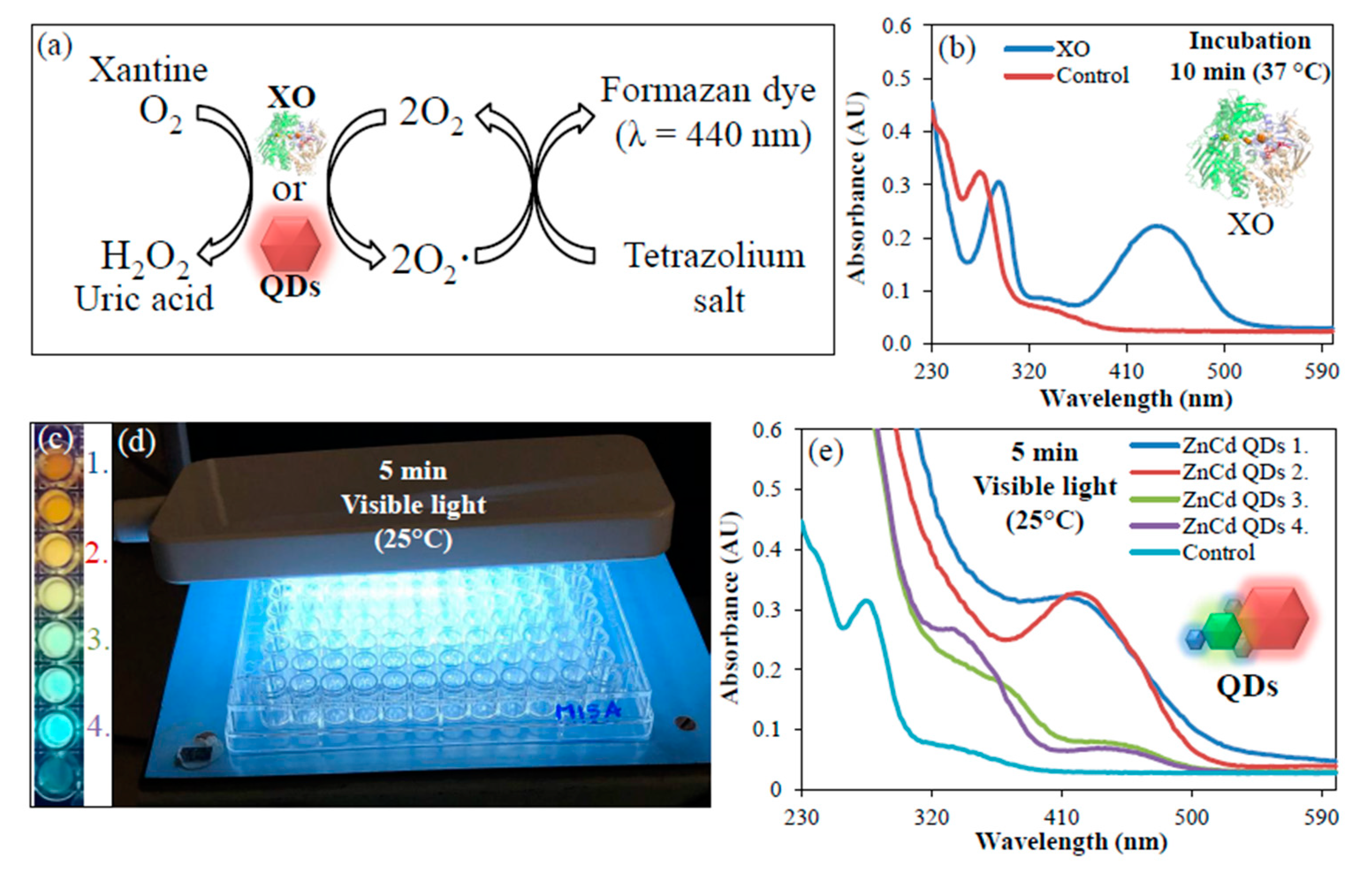UV-Induced Nanoparticles-Formation, Properties and Their Potential Role in Origin of Life
Abstract
1. Introduction
2. Materials and Methods
2.1. Chemicals
2.2. Thiols, Metals, Ions Standards and Phosphate Buffer Preparation
2.3. Solution Preparation
2.4. Layout of the Experiment
2.5. Characterization of Size and Zeta Potential of ZnCd QDs
2.6. Transmission Electron Microscopy (TEM)
2.7. Determination of Quantum Yield of ZnCd QDs
2.8. Enzymatic Reactions
3. Results and Discussion
3.1. Formation of ZnCd QDs
- (a)
- ZnCd QDs are formed by redox reactions during photodissociation/photooxidation of thiol-containing compounds with Zn(II) and Cd(II) in a short time,
- (b)
- ZnCd QDs exhibit strong fluorescence (QY = 47%),
- (c)
- ZnCd QDs grow upon UV irradiation (band gap tuning).
3.2. Influence of Ammonia (NH3) Environment on ZnCd QDs Emission Properties
4. Conclusions
Supplementary Materials
Author Contributions
Funding
Acknowledgments
Conflicts of Interest
References
- Wei, H.; Wang, E.K. Nanomaterials with enzyme-like characteristics (nanozymes): Next-generation artificial enzymes. Chem. Soc. Rev. 2013, 42, 6060–6093. [Google Scholar] [CrossRef] [PubMed]
- Wu, J.J.X.; Wang, X.Y.; Wang, Q.; Lou, Z.P.; Li, S.R.; Zhu, Y.Y.; Qin, L.; Wei, H. Nanomaterials with enzyme-like characteristics (nanozymes): Next-generation artificial enzymes (II). Chem. Soc. Rev. 2019, 48, 1004–1076. [Google Scholar] [CrossRef] [PubMed]
- Duan, J.L.; Song, L.X.; Zhan, J.H. One-Pot synthesis of highly luminescent CdTe Quantum dots by microwave irradiation reduction and their Hg2+-sensitive properties. Nano Res. 2009, 2, 61–68. [Google Scholar] [CrossRef]
- Bagga, K.; Barchanski, A.; Intartaglia, R.; Dante, S.; Marotta, R.; Diaspro, A.; Sajti, C.L.; Brandi, F. Laser-Assisted synthesis of Staphylococcus aureus protein-capped silicon quantum dots as bio-functional nanoprobes. Laser Phys. Lett. 2013, 10, 06560310. [Google Scholar] [CrossRef]
- Nejdl, L.; Zitka, J.; Mravec, F.; Milosavljevic, V.; Zitka, O.; Kopel, P.; Adam, V.; Vaculovicova, M. Real-Time monitoring of the UV-induced formation of quantum dots on a milliliter, microliter, and nanoliter scale. Microchim. Acta 2017, 184, 1489–1497. [Google Scholar] [CrossRef]
- Passos, S.G.B.; Freitas, D.V.; Dias, J.M.M.; Neto, E.T.; Navarro, M. One-Pot electrochemical synthesis of CdTe quantum dots in cavity cell. Electrochim. Acta 2016, 190, 689–694. [Google Scholar] [CrossRef]
- Ribeiro, R.T.; Dias, J.M.M.; Pereira, G.A.; Freitas, D.V.; Monteiro, M.; Cabral Filho, P.E.; Raele, R.A.; Fontes, A.; Navarro, M.; Santos, B.S. Electrochemical synthetic route for preparation of CdTe quantum-dots stabilized by positively or negatively charged ligands. Green Chem. 2013, 15, 1061–1066. [Google Scholar] [CrossRef]
- Chen, L.C.; Tseng, Z.L.; Chen, S.Y.; Yang, S. An ultrasonic synthesis method for high-luminance perovskite quantum dots. Ceram. Int. 2017, 43, 16032–16035. [Google Scholar] [CrossRef]
- Zhou, J.; Yang, Y.; Zhang, C.Y. Toward biocompatible semiconductor quantum dots: From biosynthesis and bioconjugation to biomedical application. Chem. Rev. 2015, 115, 11669–11717. [Google Scholar] [CrossRef]
- Vogel, W.; Urban, J.; Kundu, M.; Kulkarni, S.K. Sphalerite-Wurtzite intermediates in nanocrystalline CdS. Langmuir 1997, 13, 827–832. [Google Scholar] [CrossRef]
- Sun, M.Z.; Xu, L.G.; Qu, A.H.; Zhao, P.; Hao, T.T.; Ma, W.; Hao, C.L.; Wen, X.D.; Colombari, F.M.; de Moura, A.F.; et al. Site-Selective photoinduced cleavage and profiling of DNA by chiral semiconductor nanoparticles. Nat. Chem. 2018, 10, 821–830. [Google Scholar] [CrossRef] [PubMed]
- Winkler, W.C.; Nahvi, A.; Roth, A.; Collins, J.A.; Breaker, R.R. Control of gene expression by a natural metabolite-responsive ribozyme. Nature 2004, 428, 281–286. [Google Scholar] [CrossRef] [PubMed]
- Walther, R.; Winther, A.K.; Fruergaard, A.S.; van den Akker, W.; Sorensen, L.; Nielsen, S.M.; Olesen, M.T.J.; Dai, Y.T.; Jeppesen, H.S.; Lamagni, P.; et al. Identification and directed development of non-organic catalysts with apparent pan-enzymatic mimicry into nanozymes for efficient prodrug conversion. Angew. Chem. Int. Ed. 2019, 58, 278–282. [Google Scholar] [CrossRef] [PubMed]
- Prins, L.J. Emergence of complex chemistry on an organic monolayer. Acc. Chem. Res. 2015, 48, 1920–1928. [Google Scholar] [CrossRef] [PubMed]
- Vasas, V.; Szathmary, E.; Santos, M. Lack of evolvability in self-sustaining autocatalytic networks constraints metabolism-first scenarios for the origin of life. Proc. Natl. Acad. Sci. USA 2010, 107, 1470–1475. [Google Scholar] [CrossRef] [PubMed]
- Mulkidjanian, A.Y. On the origin of life in the Zinc world: I. Photosynthesizing, porous edifices built of hydrothermally precipitated zinc sulfide as cradles of life on Earth. Biol. Direct 2009, 4, 38. [Google Scholar] [CrossRef]
- Deduve, C. The Thioester World; Editions Frontieres: Dreux, France, 1992; pp. 1–20. [Google Scholar]
- Gilbert, W. Origin of life—The RNA world. Nature 1986, 319, 618. [Google Scholar] [CrossRef]
- Segre, D.; Ben-Eli, D.; Deamer, D.W.; Lancet, D. The lipid world. Orig. Life Evol. Biosph. 2001, 31, 119–145. [Google Scholar] [CrossRef]
- Zhang, X.V.; Martin, S.T. Driving parts of Krebs cycle in reverse through mineral photochemistry. J. Am. Chem. Soc. 2006, 128, 16032–16033. [Google Scholar] [CrossRef]
- Evans, M.C.W.; Buchanan, B.B.; Arnon, D.I. A new ferredoxin-dependent carbon reduction cycle in a photosynthetic bacterium. Proc. Natl. Acad. Sci. USA 1966, 55, 928–934. [Google Scholar] [CrossRef]
- Wachtershauser, G. Chemoautotrophic Origin of Life: The Iron-Sulfur World Hypothesis; Springer: Berlin, Germany, 2010; pp. 1–35. [Google Scholar] [CrossRef]
- Lazcano, A.; Miller, S.L. The origin and early evolution of life: Prebiotic chemistry, the pre-RNA world, and time. Cell 1996, 85, 793–798. [Google Scholar] [CrossRef]
- Liu, X.; Gao, H.; Ward, J.E.; Liu, X.; Yin, B.; Fu, T.; Chen, J.; Lovley, D.R.; Yao, J. Power generation from ambient humidity using protein nanowires. Nature 2020, 578. [Google Scholar] [CrossRef]
- Tilley, R.D.; Cheong, S. Earthworms lit with quantum dots. Nat. Nanotechnol. 2013, 8, 6–7. [Google Scholar] [PubMed]
- Whittet, D.C.B. Is extraterrestrial organic matter relevant to the origin of life on earth? Orig. Life Evol. Biosph. 1997, 27, 249–262. [Google Scholar] [CrossRef] [PubMed]
- Holland, H.D. The oxygenation of the atmosphere and oceans. Philos. Trans. R. Soc. B Biol. Sci. 2006, 361, 903–915. [Google Scholar] [CrossRef]
- Gaillard, F.; Scaillet, B. A theoretical framework for volcanic degassing chemistry in a comparative planetology perspective and implications for planetary atmospheres. Earth Planet. Sci. Lett. 2014, 403, 307–316. [Google Scholar] [CrossRef]
- Pastorek, A.; Hrncirova, J.; Jankovic, L.; Nejdl, L.; Civis, S.; Ivanek, O.; Shestivska, V.; Knizek, A.; Kubelik, P.; Sponer, J.; et al. Prebiotic synthesis at impact craters: The role of Fe-clays and iron meteorites. Chem. Commun. 2019, 55, 10563–10566. [Google Scholar] [CrossRef] [PubMed]
- Vazquez, G.A.; Leitherer, C. Optimization of Starburst99 for intermediate-age and old stellar populations. Astrophys. J. 2005, 621, 695–717. [Google Scholar] [CrossRef]
- Cockell, C.S. Biological effects of high ultraviolet radiation on early Earth—A theoretical evaluation. J. Theor. Biol. 1998, 193, 717–729. [Google Scholar] [CrossRef] [PubMed]
- Bonfio, C.; Valer, L.; Scintilla, S.; Shah, S.; Evans, D.J.; Jin, L.; Szostak, J.W.; Sasselov, D.D.; Sutherland, J.D.; Mansy, S.S. UV-light-driven prebiotic synthesis of iron-sulfur clusters. Nat. Chem. 2017, 9, 1229–1234. [Google Scholar] [CrossRef]
- Westall, F. Early Life on Earth: The Ancient Fossil Record; Springer: Dordrecht, The Netherlands, 2004; Volume 305, pp. 287–316. [Google Scholar]
- Cooper, G.W.; Onwo, W.M.; Cronin, J.R. Alkyl phosphonic-acids and sulfonic-acids in the Murchison meteorite. Geochim. Cosmochim. Acta 1992, 56, 4109–4115. [Google Scholar] [CrossRef]
- Gorrell, I.B.; Wang, L.M.; Marks, A.J.; Bryant, D.E.; Bouillot, F.; Goddard, A.; Heard, D.E.; Kee, T.P. On the origin of the Murchison meteorite phosphonates. Implications for pre-biotic chemistry. Chem. Commun. 2006, 1643–1645. [Google Scholar] [CrossRef] [PubMed]
- Yamagata, Y.; Watanabe, H.; Saitoh, M.; Namba, T. Volcanic production of polyphosphates and its relevance to prebiotic evolution. Nature 1991, 352, 516–519. [Google Scholar] [CrossRef] [PubMed]
- Kuznetsova, Y.V.; Rempel, A.A. Size, zeta potential, and semiconductor properties of hybrid CdS-ZnS nanoparticles in a stable aqueous colloidal solution. Russ. J. Phys. Chem. A 2017, 91, 1105–1108. [Google Scholar] [CrossRef]
- Medintz, I.L.; Uyeda, H.T.; Goldman, E.R.; Mattoussi, H. Quantum dot bioconjugates for imaging, labelling and sensing. Nat. Mater. 2005, 4, 435–446. [Google Scholar] [CrossRef]
- Campbell, C.T. The energetics of supported metal nanoparticles: Relationships to sintering rates and catalytic activity. Acc. Chem. Res. 2013, 46, 1712–1719. [Google Scholar] [CrossRef]
- Cao, S.W.; Tao, F.; Tang, Y.; Li, Y.T.; Yu, J.G. Size- and shape-dependent catalytic performances of oxidation and reduction reactions on nanocatalysts. Chem. Soc. Rev. 2016, 45, 4747–4765. [Google Scholar] [CrossRef]
- Pizzarello, S.; Williams, L.B.; Lehman, J.; Holland, G.P.; Yarger, J.L. Abundant ammonia in primitive asteroids and the case for a possible exobiology. Proc. Natl. Acad. Sci. USA 2011, 108, 4303–4306. [Google Scholar] [CrossRef]
- Bickley, R.I.; Vishwanathan, V. Photocatalytically induced fixation of molecular nitrogen by near UV-radiation. Nature 1979, 280, 306–308. [Google Scholar] [CrossRef]
- Schoonen, M.A.A.; Xu, Y. Nitrogen reduction under hydrothermal vent conditions: Implications for the prebiotic synthesis of C-H-O-N compounds. Astrobiology 2001, 1, 133–142. [Google Scholar] [CrossRef] [PubMed]
- Pullerits, T.; Sundstrom, V. Photosynthetic light-harvesting pigment-protein complexes: Toward understanding how and why. Acc. Chem. Res. 1996, 29, 381–389. [Google Scholar] [CrossRef]
- Lv, H.J.; Wang, C.C.; Li, G.C.; Burke, R.; Krauss, T.D.; Gao, Y.L.; Eisenberg, R. Semiconductor quantum dot-sensitized rainbow photocathode for effective photoelectrochemical hydrogen generation. Proc. Natl. Acad. Sci. USA 2017, 114, 11297–11302. [Google Scholar] [CrossRef] [PubMed]
- Mulkidjanian, A.Y.; Galperin, M.Y. On the origin of life in the Zinc world. 2. Validation of the hypothesis on the photosynthesizing zinc sulfide edifices as cradles of life on Earth. Biology Direct. 2009, 4, 1–37. [Google Scholar] [CrossRef] [PubMed]
- Skalickova, S.; Zitka, O.; Nejdl, L.; Krizkova, S.; Sochor, J.; Janu, L.; Ryvolova, M.; Hynek, D.; Zidkova, J.; Zidek, V.; et al. Study of interaction between metallothionein and CdTe quantum dots. Chromatographia 2013, 76, 345–353. [Google Scholar] [CrossRef]
- Nejdl, L.; Hynek, D.; Adam, V.; Vaculovicova, M. Capillary electrophoresis-driven synthesis of water-soluble CdTe quantum dots in nanoliter scale. Nanotechnology 2018, 29, 6. [Google Scholar] [CrossRef] [PubMed]
- Nejdl, L.; Skalickova, S.; Kudr, J.; Ruttkay-Nedecky, B.; Nguyen, H.V.; Rodrigo, M.A.M.; Kopel, P.; Konecna, M.; Adam, V.; Kizek, R. Interaction of E6 gene from Human Papilloma Virus 16 (HPV-16) with CdS quantum dots. Chromatographia 2014, 77, 1433–1439. [Google Scholar] [CrossRef]
- Litwinienko, G.; Beckwith, A.L.J.; Ingold, K.U. The frequently overlooked importance of solvent in free radical syntheses. Chem. Soc. Rev. 2011, 40, 2157–2163. [Google Scholar] [CrossRef]
- Mota-Morales, J.D.; Sanchez-Leija, R.J.; Carranza, A.; Pojman, J.A.; del Monte, F.; Luna-Barcenas, G. Free-Radical polymerizations of and in deep eutectic solvents: Green synthesis of functional materials. Prog. Polym. Sci. 2018, 78, 139–153. [Google Scholar] [CrossRef]
- Nomoto, A.; Higuchi, Y.; Kobiki, Y.; Ogawa, A. Synthesis of selenium compounds by free radical addition based on visible-light-activated Se-Se bond cleavage. Mini Rev. Med. Chem. 2013, 13, 814–823. [Google Scholar] [CrossRef]
- Aslam, U.; Rao, V.G.; Chavez, S.; Linic, S. Catalytic conversion of solar to chemical energy on plasmonic metal nanostructures. Nat. Catal. 2018, 1, 656–665. [Google Scholar] [CrossRef]
- Cavosie, A.J.; Valley, J.W.; Wilde, S.A. Magmatic delta O-18 in 4400-3900 Ma detrital zircons: A record of the alteration and recycling of crust in the Early Archean. Earth Planet. Sci. Lett. 2005, 235, 663–681. [Google Scholar] [CrossRef]
- Catling, D.C.; Zahnle, K.J. The Archean atmosphere. Sci. Adv. 2020, 6, 16. [Google Scholar] [CrossRef]
- Sleep, N.H.; Zahnle, K. Refugia from asteroid impacts on early Mars and the early Earth. J. Geophys. Res. Planets 1998, 103, 28529–28544. [Google Scholar] [CrossRef]
- Mojzsis, S.J.; Arrhenius, G.; McKeegan, K.D.; Harrison, T.M.; Nutman, A.P.; Friend, C.R.L. Evidence for life on Earth before 3800 million years ago. Nature 1996, 384, 55–59. [Google Scholar] [CrossRef] [PubMed]
- Tashiro, T.; Ishida, A.; Hori, M.; Igisu, M.; Koike, M.; Mejean, P.; Takahata, N.; Sano, Y.; Komiya, T. Early trace of life from 3.95 Ga sedimentary rocks in Labrador, Canada. Nature 2017, 549, 516–518. [Google Scholar] [CrossRef]
- Bell, E.A.; Boehnke, P.; Harrison, T.M.; Mao, W.L. Potentially biogenic carbon preserved in a 4.1 billion-year-old zircon. Proc. Natl. Acad. Sci. USA 2015, 112, 14518–14521. [Google Scholar] [CrossRef] [PubMed]
- Dodd, M.S.; Papineau, D.; Grenne, T.; Slack, J.F.; Rittner, M.; Pirajno, F.; O’Neil, J.; Little, C.T.S. Evidence for early life in Earth’s oldest hydrothermal vent precipitates. Nature 2017, 543, 60–64. [Google Scholar] [CrossRef]
- Nishimura, M.; Sandell, E.B. Zinc in meteorites. Geochim. Cosmochim. Acta 1964, 28, 1055–1079. [Google Scholar] [CrossRef]
- Schmitt, R.A.; Goles, G.G.; Smith, R.H.; Osborn, T.W. Elemental abundances in stone meteorites. Meteoritics 1972, 7, 131–213. [Google Scholar] [CrossRef]
- Kruijer, T.S.; Sprung, P.; Kleine, T.; Leya, I.; Wieler, R. The abundance and isotopic composition of Cd in iron meteorites. Meteorit. Planet. Sci. 2013, 48, 2597–2607. [Google Scholar] [CrossRef]
- Schwenzer, S.P.; Abramov, O.; Allen, C.C.; Bridges, J.C.; Clifford, S.M.; Filiberto, J.; Kring, D.A.; Lasue, J.; McGovern, P.J.; Newsom, H.E.; et al. Gale Crater: Formation and post-impact hydrous environments. Planet. Space Sci. 2012, 70, 84–95. [Google Scholar] [CrossRef]
- Berger, J.A.; Schmidt, M.E.; Gellert, R.; Boyd, N.I.; Desouza, E.D.; Flemming, R.L.; Izawa, M.R.M.; Ming, D.W.; Perrett, G.M.; Rampe, E.B.; et al. Zinc and germanium in the sedimentary rocks of Gale Crater on Mars indicate hydrothermal enrichment followed by diagenetic fractionation. J. Geophys. Res. Planets 2017, 122, 1747–1772. [Google Scholar] [CrossRef]
- Heinz, J.; Schulze-Makuch, D. Thiophenes on Mars: Biotic or abiotic origin? Astrobiology 2020, 20, 552–561. [Google Scholar] [CrossRef]
- Cody, G.D. Transition metal sulfides and the origins of metabolism. Annu. Rev. Earth Planet. Sci. 2004, 32, 569–599. [Google Scholar] [CrossRef]
- McCollom, T.M. Laboratory simulations of abiotic hydrocarbon formation in Earth’s deep subsurface. In Carbon in Earth; Hazen, R.M., Jones, A.P., Baross, J.A., Eds.; Mineralogical Soc Amer & Geochemical Soc: Chantilly, France, 2013; Volume 75, pp. 467–494. [Google Scholar]
- McCollom, T.M. Miller-Urey and beyond: What have we learned about prebiotic organic synthesis reactions in the past 60 years? Annu. Rev. Earth Planet. Sci. 2013, 41, 207–229. [Google Scholar] [CrossRef]
- Ding, K.; Seyfried, W.E.; Zhang, Z.; Tivey, M.K.; Von Damm, K.L.; Bradley, A.M. The in situ pH of hydrothermal fluids at mid-ocean ridges. Earth Planet. Sci. Lett. 2005, 237, 167–174. [Google Scholar] [CrossRef]
- Sekine, Y.; Shibuya, T.; Postberg, F.; Hsu, H.W.; Suzuki, K.; Masaki, Y.; Kuwatani, T.; Mori, M.; Hong, P.K.; Yoshizaki, M.; et al. High-Temperature water-rock interactions and hydrothermal environments in the chondrite-like core of Enceladus. Nat. Commun. 2015, 6, 8. [Google Scholar] [CrossRef]
- Ritson, D.J.; Mojzsis, S.J.; Sutherland, J.D. Supply of phosphate to early Earth by photogeochemistry after meteoritic weathering. Nat. Geosci. 2020, 13, 6. [Google Scholar] [CrossRef]
- Saladino, R.; Botta, G.; Pino, S.; Costanzo, G.; Di Mauro, E. Genetics first or metabolism first? The formamide clue. Chem. Soc. Rev. 2012, 41, 5526–5565. [Google Scholar] [CrossRef]



© 2020 by the authors. Licensee MDPI, Basel, Switzerland. This article is an open access article distributed under the terms and conditions of the Creative Commons Attribution (CC BY) license (http://creativecommons.org/licenses/by/4.0/).
Share and Cite
Nejdl, L.; Zemankova, K.; Havlikova, M.; Buresova, M.; Hynek, D.; Xhaxhiu, K.; Mravec, F.; Matouskova, M.; Adam, V.; Ferus, M.; et al. UV-Induced Nanoparticles-Formation, Properties and Their Potential Role in Origin of Life. Nanomaterials 2020, 10, 1529. https://doi.org/10.3390/nano10081529
Nejdl L, Zemankova K, Havlikova M, Buresova M, Hynek D, Xhaxhiu K, Mravec F, Matouskova M, Adam V, Ferus M, et al. UV-Induced Nanoparticles-Formation, Properties and Their Potential Role in Origin of Life. Nanomaterials. 2020; 10(8):1529. https://doi.org/10.3390/nano10081529
Chicago/Turabian StyleNejdl, Lukas, Kristyna Zemankova, Martina Havlikova, Michaela Buresova, David Hynek, Kledi Xhaxhiu, Filip Mravec, Martina Matouskova, Vojtech Adam, Martin Ferus, and et al. 2020. "UV-Induced Nanoparticles-Formation, Properties and Their Potential Role in Origin of Life" Nanomaterials 10, no. 8: 1529. https://doi.org/10.3390/nano10081529
APA StyleNejdl, L., Zemankova, K., Havlikova, M., Buresova, M., Hynek, D., Xhaxhiu, K., Mravec, F., Matouskova, M., Adam, V., Ferus, M., Kapus, J., & Vaculovicova, M. (2020). UV-Induced Nanoparticles-Formation, Properties and Their Potential Role in Origin of Life. Nanomaterials, 10(8), 1529. https://doi.org/10.3390/nano10081529







